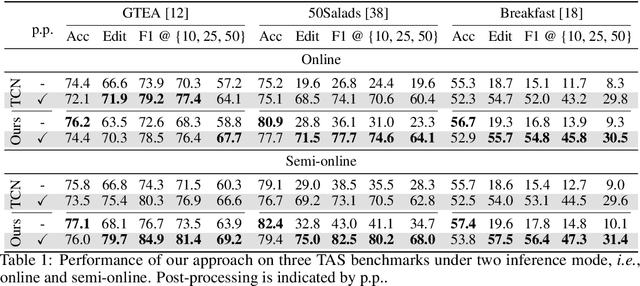Qing Zhong
Strategic priorities for transformative progress in advancing biology with proteomics and artificial intelligence
Feb 21, 2025

Abstract:Artificial intelligence (AI) is transforming scientific research, including proteomics. Advances in mass spectrometry (MS)-based proteomics data quality, diversity, and scale, combined with groundbreaking AI techniques, are unlocking new challenges and opportunities in biological discovery. Here, we highlight key areas where AI is driving innovation, from data analysis to new biological insights. These include developing an AI-friendly ecosystem for proteomics data generation, sharing, and analysis; improving peptide and protein identification and quantification; characterizing protein-protein interactions and protein complexes; advancing spatial and perturbation proteomics; integrating multi-omics data; and ultimately enabling AI-empowered virtual cells.
OnlineTAS: An Online Baseline for Temporal Action Segmentation
Nov 02, 2024



Abstract:Temporal context plays a significant role in temporal action segmentation. In an offline setting, the context is typically captured by the segmentation network after observing the entire sequence. However, capturing and using such context information in an online setting remains an under-explored problem. This work presents the an online framework for temporal action segmentation. At the core of the framework is an adaptive memory designed to accommodate dynamic changes in context over time, alongside a feature augmentation module that enhances the frames with the memory. In addition, we propose a post-processing approach to mitigate the severe over-segmentation in the online setting. On three common segmentation benchmarks, our approach achieves state-of-the-art performance.
CTVIS: Consistent Training for Online Video Instance Segmentation
Jul 24, 2023Abstract:The discrimination of instance embeddings plays a vital role in associating instances across time for online video instance segmentation (VIS). Instance embedding learning is directly supervised by the contrastive loss computed upon the contrastive items (CIs), which are sets of anchor/positive/negative embeddings. Recent online VIS methods leverage CIs sourced from one reference frame only, which we argue is insufficient for learning highly discriminative embeddings. Intuitively, a possible strategy to enhance CIs is replicating the inference phase during training. To this end, we propose a simple yet effective training strategy, called Consistent Training for Online VIS (CTVIS), which devotes to aligning the training and inference pipelines in terms of building CIs. Specifically, CTVIS constructs CIs by referring inference the momentum-averaged embedding and the memory bank storage mechanisms, and adding noise to the relevant embeddings. Such an extension allows a reliable comparison between embeddings of current instances and the stable representations of historical instances, thereby conferring an advantage in modeling VIS challenges such as occlusion, re-identification, and deformation. Empirically, CTVIS outstrips the SOTA VIS models by up to +5.0 points on three VIS benchmarks, including YTVIS19 (55.1% AP), YTVIS21 (50.1% AP) and OVIS (35.5% AP). Furthermore, we find that pseudo-videos transformed from images can train robust models surpassing fully-supervised ones.
 Add to Chrome
Add to Chrome Add to Firefox
Add to Firefox Add to Edge
Add to Edge